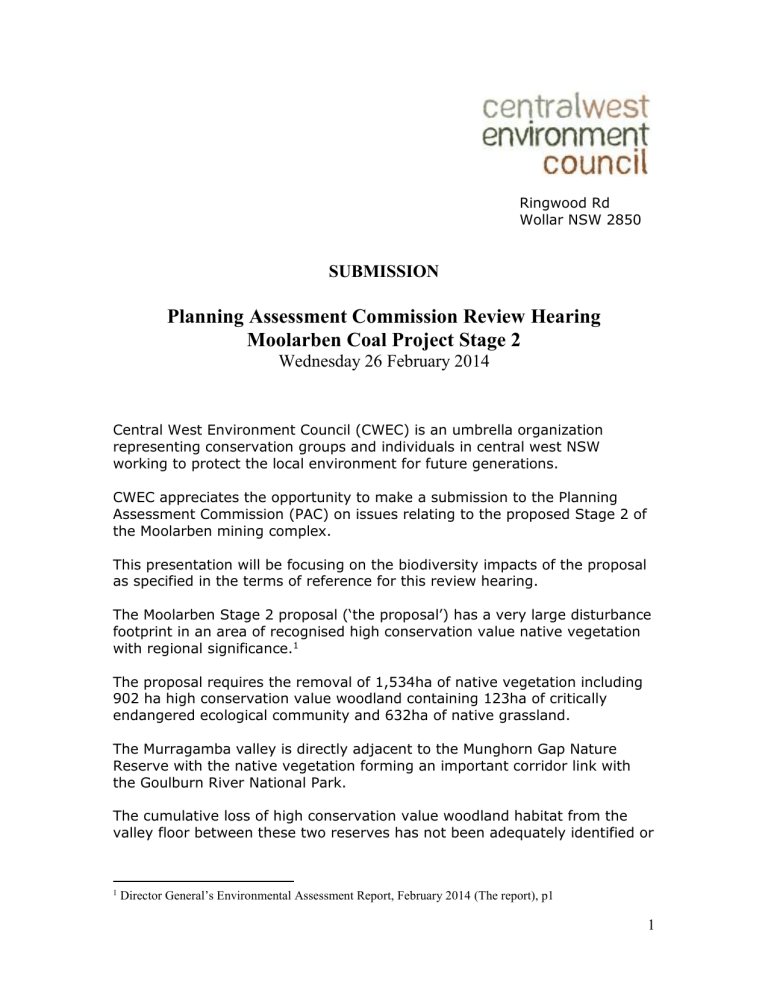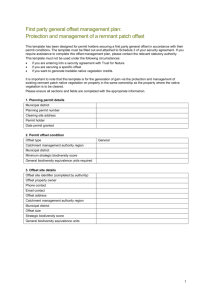NSW Moolarben - Central West Environment Council

Ringwood Rd
Wollar NSW 2850
SUBMISSION
Planning Assessment Commission Review Hearing
Moolarben Coal Project Stage 2
Wednesday 26 February 2014
Central West Environment Council (CWEC) is an umbrella organization representing conservation groups and individuals in central west NSW working to protect the local environment for future generations.
CWEC appreciates the opportunity to make a submission to the Planning
Assessment Commission (PAC) on issues relating to the proposed Stage 2 of the Moolarben mining complex.
This presentation will be focusing on the biodiversity impacts of the proposal as specified in the terms of reference for this review hearing.
The Moolarben Stage 2 proposal (‘the proposal’) has a very large disturbance footprint in an area of recognised high conservation value native vegetation with regional significance.
1
The proposal requires the removal of 1,534ha of native vegetation including
902 ha high conservation value woodland containing 123ha of critically endangered ecological community and 632ha of native grassland.
The Murragamba valley is directly adjacent to the Munghorn Gap Nature
Reserve with the native vegetation forming an important corridor link with the Goulburn River National Park.
The cumulative loss of high conservation value woodland habitat from the valley floor between these two reserves has not been adequately identified or
1 Director General’s Environmental Assessment Report, February 2014 (The report), p1
1
assessed in the Director General’s Environmental Assessment Report (‘the report’).
The approved offsets for the loss of significant woodland biodiversity values for the Wilpinjong, Moolarben Stage 1and Ulan projects are inadequate and mostly based on long term habitat restoration programs.
CWEC considers that the regulation of the conditions of approval for biodiversity offset management is very limited.
There has been no rigorous assessment of the effectiveness of these conditions of approval for significant habitat loss in the region since the recent rapid expansion of mining operations commenced in 2005.
The proposed additional removal of a further 1,534ha of native vegetation that supports habitat for 36 threatened species cannot be adequately offset.
This submission will provide further detail on the inadequacy of the biodiversity offset strategy for the proposal.
CWEC notes that the original assessment of the vegetation communities proposed to be destroyed were required by the Office of Environment and
Heritage (OEH) to be reclassified for consistency with the biobanking conventions.
CWEC also notes that Cumberland Ecology was commissioned to undertake the review of the adequacy of the flora and fauna assessment and additional information provided in response to submissions and also to assist with the reclassification of the vegetation communities. Cumberland Ecology was also engaged to prepare the biodiversity offset strategy.
CWEC is aware that Cumberland Ecology is currently being investigated for the mis-identification of endangered ecological communities in the offset assessment for a large mining proposal in north western NSW. This has reduced confidence in the quality of ecological assessment undertaken for the significant biodiversity impacts of this proposal.
The report in Table 9 2 identifies nine vegetation communities to be removed from the Murragamba valley if the proposal is approved. This includes 123ha of critically endangered ecological communities (EEC) listed for protection under the Environment Protection and Biodiversity Conservation Act 1999
(EPBC Act).
The report notes that the Department of Planning and Infrastructure (‘the
Department’) is satisfied that the implementation of the biodiversity strategy,
2 The report p50
2
coupled with the rehabilitation strategy, will mitigate the biodiversity impacts in the medium to long term.
3
However, there is no consideration of the immediate impacts on threatened species through significant cumulative loss of habitat or on the viability of the proposed environmental restoration and rehabilitation in the face of predicted climate change impacts.
The report in Table 11 4 identifies that the proposed biodiversity offset strategy has a number of significant shortfalls for various vegetation communities proposed to be destroyed. These shortfalls include:
77 ha of Blakely’s Redgum-Yellow Box grassy open forest or woodland of the
New England Tableland EEC
171 ha of Grey Gum – Narrow-leaved Stringybark – Ironbark woodland on the ridges of the Upper Hunter Valley, Sydney Basin
242 ha of Rough-barked Apple – Coast Banksia shrubby woodland on
Warkworth Sands of the central Hunter Valley, Sydney Basin
54 ha of Slaty Box – Grey Gum shrubby woodland on the footslopes of the upper Hunter Valley, Brigalow Belt South
80 ha of Scribbly Gum – Brown Bloodwood woodland of the southern
Brigalow Belt South
27 ha of Grey Box – Narrow-leaved Ironbark shrubby woodlands on the hills of the Hunter Valley, North Coast and Sydney Basin
4 ha of White Box – Narrow-leaved Ironbark open forest on hills of central
Hunter Valley, Sydney Basin
443 ha of Derived grasslands of the slopes on the Merriwa Plateau
Of the 1,411 ha of non-threatened vegetation communities to be destroyed, including some significant range extensions, only 390 ha will be represented within proposed offset arrangements.
The proposed offset strategy of 3,612 ha of non-threatened vegetation communities contains 3,225 ha of vegetation communities that do not occur in the disturbance area of the proposal.
The proposed offset strategy of 1,182 ha of EEC contains 343 ha of other types of EEC not impacted by the proposal.
3 The report p58
4 The report p58
3
The conclusion that the biodiversity offset would result in offset ratios of
1:2.1 for native vegetation and 1:9.5 for EECs and an overall offset ratio of
1:2.7 is not based on any clear evidence, particularly when 77 ha of an impacted EEC will not be directly offset.
The figures in Table 10 5 outlining the vegetation in the proposed offset areas
(totaling 4,066 ha on the offset properties) are not consistent with the information provided in Table 11which has an offset total of 4,794 ha.
The inclusion of rehabilitation of mined land in calculations of offsets for EEC is very optimistic. CWEC is not aware of any proven successful establishment of Grassy Box Woodland on mine overburden anywhere in NSW.
CWEC, along with OEH and other interest groups, has raised concerns about the distance of some of the proposed offset properties and their lack of ‘like for like’ vegetation values.
CWEC notes the Department comments that it is becoming more difficult for suitable offset land to be found near mine sites and that large areas of land are under existing mining tenement and long term conservation cannot be assured.
CWEC would like to bring to the PACs attention that the recent addition to the proposed offset lands of Old Bobadeen is within the Moolarben exploration licence area 6288. Exploration drilling at six sites on the block has already occured.
This land, owned by Moolarben Coal, was added to the Biodiversity Offset
Strategy to provide more adequate compensation for the area to be cleared for mining and an opportunity for regeneration of EEC. Any future mining impacts on this offset area will negate any gains made in the negotiations with OEH for improved offset ratios for Moolarben Stage 2.
CWEC recommends that, if the PAC considers recommending the approval of the proposal, the draft condition of consent Schedule 3 clause 28 be strengthened so that:
By June 30 2015 the Proponent shall make arrangements to transfer the offset areas in Table 11 to the National Parks and Wildlife Service to be dedicated as National Park under the National Parks and Wildlife Act 1974.
CWEC also recommends that the draft condition of consent Schedule 3 clause
31 (noting that there is no clause 30)
By June 30 2015 the Proponent shall lodge a Conservation Bond with Office of Environment and Heritage to enable the implementation of the biodiversity
5 The Rpeort p 53
4
strategy on offset lands. The sum of the bond shall be determined by calculating the full cost of implementing the biodiversity offset strategy with appropriate officers of the National Parks and Wildlife Service.
Finally, CWEC along with other representatives and community members here today recommends that the PAC include a condition of consent that requires the Drip Gorge and surrounding lands to be immediately gazetted as
National Park in an extension of the Goulburn River National Park.
5





